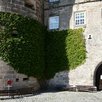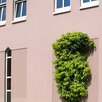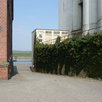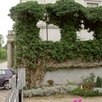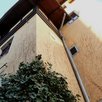Ivy (English Ivy) ~ General Info
As an evergreen climber, ivy is especially loved for its capacity to fully cover any wall or facade, but it can also be trained to cover smaller, more defined spaces on a facade. Ivy shoots grow away from sunlight, and tend to climb their way inside any crack or crevice in the wall, potentially causing structural damage as the shoots grow thick. Ivy needs to be kept in check for this reason, and requires a generous amount of maintaining and pruning an ivy. For smaller surfaces, wintercreeper could be used instead.
(Common ivy, lat.: Hedera helix // colchica // hibernica)

To Thrive...
Ivy does well in a sunny to semi-shaded location with a nutrient- and humus-rich soil and good water provision. Distance between plants: 2 - 8 metres.
Charateristics and Pruning
Ivy is a self-climber, often cascading, that may grow to a height of 20 metres or more. Of particular interest for facade greening are the wild- i.e., non-hybridised species and young ('juvenile') forms, which are generally good climbers with clinging rootlets and, in temperate climates (zone 6a and up), reliably evergreen.
The native form - Hedera helix - is a particularly reliable climber, while Hedera colchica is reliable only in optimal conditions (locations). The Irish ivy Hedera helix "Hibernica" is particularly vigorous, but its root system is less effective. Hedera helix "Woerner" is the hardiest of the bunch, grows quickly, and clings firmly to walls; for these reasons it is FassadenGrün's favourite ivy. When an ivy cannot climb any higher, it will stop producing its adhesive rootlets to climb and will develop its mature form “arborescens,” which has simple oval, acuminate leaves instead of lobed ones, grows as a shrub only, and is sold as a different species altogether. Flowers appear in September~ a fragrant feast for bees! Fruits (berries) come during or after winter and provide food for birds. Pruning is possible at any time and is usually necessary to keep its growth in check, as you will see in the photos below.
Climbing Supports for the Facade
For heights of 6 meters or more, a wire rope trellis is strongly recommended to assist climbing and adhesion, and most of all to prevent the ivy from collapsing. Entire areas of an ivy mat can become detached in storms or strong winds. During a storm, and especially if the wall plaster is old and brittle, entire leaf mats can separate and collapse. For suitable rope systems, refer to the table below. Easy basic and medium kits are recommended; for higher greening, go with heavy or even massive systems. Ivy can be woven into fences, wire nets, trellises, etc.. for a decorative touch. Light, easy basic-s or easy mini kits would be sufficient for this purpose and for potted ivy plants.
The unflattering side of ivy... A few things to know
The fruit of the ivy is poisonous and its leaves can irritate the skin. Ivy grows away from the light and if left unchecked, can cause considerable structural damage, especially if brickwork and render already have cracks into which the ivy is more than pleased to enter... eventually bursting structures with their thick-growing stems. We are frequently asked how to deal with the adhesive roots that remain on the wall when the ivy is removed (from a facade during its renovation, for example). The only sure way is to burn off / torch the plant traces and repaint the wall. An alternative to the complete removal of ivy is preventing it from climbing higher through the use of horizontal barriers in the form of cornices (projective window sills) or by framing the ivy with segments of sheet metal installed at a certain height, at least temporarily until the next pruning.

Greening Other Structures with Ivy
Ivy also thrives on banisters, parking garages, and pergolas. See this gallery for some examples...
Wire Rope Systems for Ivy
Please click on the graphic illustrations for details!
| = suitable | = of limited suitability | = unsuitable |



